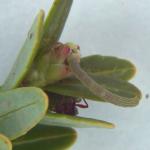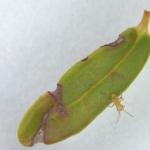Insect Management. The 2024 bug season has begun! Monday and Tuesday this week had warm days and weevil made a star appearance. Where cranberry weevil has been a historic problem, you could go sweep those spots and get 10 or 20 weevil. Other sites had 0, 2, or 4 counts. Weevil should be mostly on blueberry at this time, and they were found there too. With the return of cold, overcast weather, you will have a hard time finding them again! Thursday reports were much lower! On the next sunny day over 70 degrees you should drop a net to find out what the numbers are on your bog. Treatment should be timed to target population when most have moved onto the bog (perhaps 2 weeks from now). Avaunt, Actara and Fanfare are your choices for populations over 4.5 weevil counts across a bog.
Picture shows a green spanworm feeding on a developing bud with a weevil waiting his turn.
Green spanworm (tiny green inchworms) have definitely hatched and are out on the bog now. Only low counts (0, 1, 2, 3) were detected but they have begun! These spanworms will be feeding for the next 3 weeks before they pupate, and moths appear mid-June. Remember, they don’t get as big as our cutworms and the threshold is much higher.
Picture on left show the 2 sizes of green spanworm collected this week; small and really small. Picture on right shows a tiny black bug nymph currently out on some low input bogs (yes, the black bug nymph is yellow right now).
When you do sweep, be aware of the tiny yellow specks in the sweep net. Most of these tiny specks are collembola (springtails) that do not eat cranberry or cause trouble, but some may be the fast-moving nymphal black bugs (that are yellow as nymphs)! These black bug nymphs feed on new growth and cause damage that results in vegetative growth, resulting in very low yield. They will appear yellow for the next week or so, then green before gradual metamorphosis to black bugs in July.
The Cranberry Station is hosting an Insect Clinic on May 22 from 8-10 AM to learn more about and how to ID black bug, blunt nosed leafhopper and scale. An introductory discussion will be followed by a hands-on lab ID with samples from the bog. The in-person session offers 2 credits and it's FREE to participate. To sign up please contact Marty Sylvia martys@umass.edu or 508-265-6921.
Disease Management. As cranberry bud development progresses, it is time to think about upright dieback and Fairy Ring. For upright dieback control, chlorothalonil applications at bud break and/or early bud expansion give excellent control of the disease. Time application for when the bud has broken dormancy and new growth has begun (elongation period prior to roughneck). The first spray for Fairy Ring control is also timed for budbreak. A combination spray of Indar and Abound is recommended. Please see the Chart Book for details.
Weed Management. There are now reports of dodder seedlings germinating on bogs (we first heard on May 7th, but it is possible it started even earlier in some areas). Scout your bog to time herbicide applications for dodder. Search in the canopy and/or in areas where you off-load your fruit and trash. These are the best places to find dodder seedlings.
The window for Casoron use (which acts primarily to inhibit seed germination) is quickly closing, as applications should be made before budbreak.
Kerb Use Approved for Dodder Control as Emergency Exemption for 2024 in MA. You must have dodder on your bog to use Kerb under this Specific Exemption. Kerb provides both pre-emergence and early postemergence dodder control. It will inhibit the “searching” ability of the dodder seedlings such that they cannot successfully attach to a host. Handler restrictions will likely apply. Contact your handler PRIOR to using Kerb! Labels (available now) and MDAR reporting forms (coming soon) will be available at all ag retailers, at the Cranberry Station, and on the Cranberry Station web site.
Kerb is Zone II-restricted. If you are in a Zone II, please call Katie at the Station to determine if you qualify for a letter. You cannot apply Kerb in a Zone II without a qualifying letter.
Some growers report good control using QuinStar for preemergence dodder control.
The window for sulfentrazone products is likely closed for most (if not all) growers at this point. Do NOT apply Zeus/Spartan if your buds are at cabbagehead or beyond, or you will get vine injury.
Many growers have been questioning the best timing for grass management. There are some grass that are actively growing now, but many others like Poverty Grass will not be actively growing until later in the summer. In order to be successful with grass herbicides, you must use them at the correct time for the type of grass you are trying to control. See the May 3 newsletter for detailed information on that topic: https://ag.umass.edu/cranberry/newsletters/cranberry-station-newsletter/cranberry-station-newsletter-2024-vol-254
Late Water Bogs. For those of you holding water on inland bogs, the water should come off soon, likely by May 15. Remember that the frost tolerance will be 29.5 F as soon as the flood is removed, no matter what the buds look like. Casoron can be applied for dodder control after the flood is removed but wait for the bog to drain before applying. You still need to scout your LW bogs for spring insects, even though you will likely be able to omit the early insecticides. Nitrogen needs for the vines are usually less on LW bogs, so you can usually skip your first N application and/or reduce the fruit set dose. It is best to wait at least 2 weeks after flood removal and add small amounts and monitor the progress of growth. Generally, no fertilizer is needed before bloom, but go out and look.


